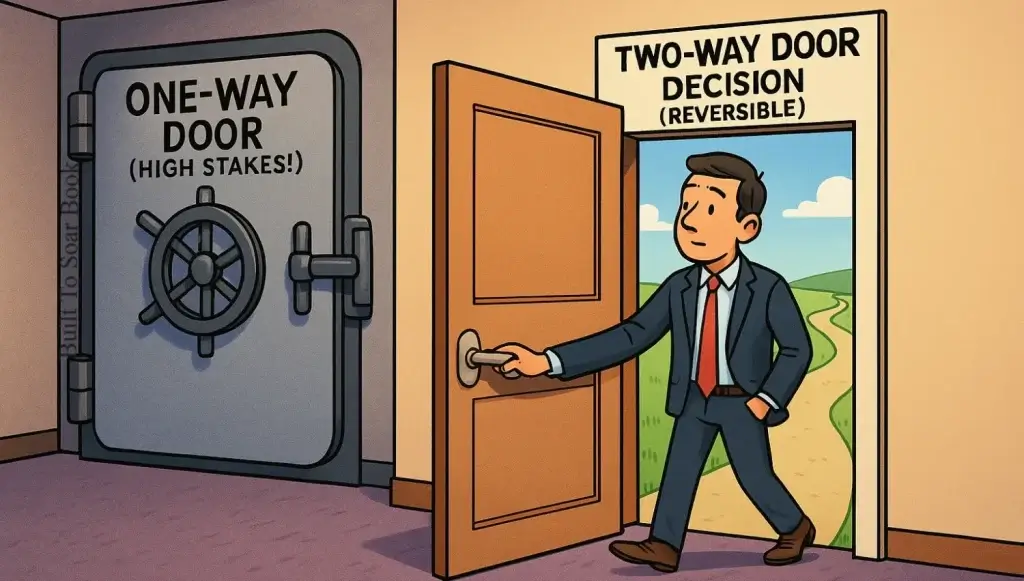You and the head of product just had a good meeting about customer needs, identifying a needed tweak in the product that requires a small engineering change.
It’s not too costly, but it’s a major pain point for the customer who left the meeting frustrated. The product manager walked off saying, “Let me think about it.” Two weeks later when you ask? He’s still thinking about it.
The decision could have been made on the spot, quickly fixing the issue, showing the customer you’re responsive, and potentially solidifying the relationship or even a sale. Instead, the delays risk losing that customer entirely. Have you experienced business delays like that “let me think about it”?
This is analysis paralysis, often intertwined with a simple fear of deciding, and it’s grounding businesses everywhere. We discuss more about this in the Built to Soar Book by Greg Born.
Lack Of Quick Decision Making
Cost Businesses Millions
In the cockpit, especially flying something complex like a C-5, we rely heavily on analysis (like the ‘A’ in MAT). But we also learn a crucial skill: matching the decision-making process to the stakes and the timeframe. Not every situation requires a deep-dive investigation. Sometimes, you need to assess quickly and act decisively based on the information you have right now. Delay isn’t just inefficient; it can be dangerous.
As leaders, we need to get better at distinguishing between the decisions that require meticulous, C-5-level pre-flight planning and those that just need a quick, confident course correction.
The Crippling Cost of Delay
We often overestimate the risk of making a wrong decision, especially for smaller issues, while drastically underestimating the cost of delay. What does analysis paralysis and fear-based hesitation cost you?
- Missed Opportunities: While you’re “thinking about it,” a competitor acts.
- Lost Momentum: Teams get frustrated and disengaged when decisions linger.
- Wasted Resources: Time spent in endless meetings and data gathering for low-impact decisions is time not spent on high-impact work.
- Cultural Impact: It fosters a risk-averse culture driven by fear – fear of making the wrong decision, fear of accountability, or sometimes just fear of making any decision. Action gets discouraged, and “covering your backside” with more analysis becomes the norm.
Pilot Thinking: Categorizing Decisions
Pilots constantly make decisions, but we don’t treat them all the same:
- High-Stakes / Irreversible: Engine failure, structural damage, landing in minimum visibility. These demand rigorous adherence to procedures (checklists) and careful analysis (MAT). The cost of error is catastrophic.
- Moderate Stakes / Time-Sensitive: Deviating around weather, adjusting flight path for traffic, managing a minor system glitch. These require quick assessment using available data and decisive action based on training and experience. Delay can escalate the problem.
- Low-Stakes / Routine Adjustments: Minor altitude or heading changes, routine communications. These are handled almost instinctively based on standard practices. Overthinking is unnecessary and inefficient.
The key is recognizing which category a decision falls into. We don’t run a full emergency checklist for a minor heading adjustment.

Enter the “Two-Way Door”: Making Reversible Decisions Faster
Jeff Bezos famously talked about “one-way doors” and “two-way doors.”
- One-Way Doors: Big, strategic decisions that are very hard or impossible to reverse (e.g., acquiring a company, launching a major new product line). These deserve deep analysis and careful deliberation.
- Two-Way Doors: Decisions where, if you make a mistake, you can easily walk back through the door, reverse course, and try something else without causing catastrophic damage (e.g., testing a new website headline, trying a different meeting format, adjusting an internal process).
Many businesses treat every decision like a one-way door
The problem? Businesses often treat every decision like a one-way door. We apply the same level of scrutiny and demand for certainty to easily reversible choices as we do to bet-the-company moves. That’s where analysis paralysis, often fueled by fear, takes hold.
For those “two-way door” decisions, speed and iteration are often more valuable than perfect, slow analysis. Make the call, see what happens, learn, and adjust.
A Quick “Go/No-Go” for Faster Decisions
Need to break the “let me think about it” habit for lower-stakes issues? Ask these quick questions:
- Is this decision easily reversible? (Is it a two-way door?) If yes, lean towards acting faster.
- What’s the realistic worst-case impact if I’m wrong? If it’s minor (e.g., a slight dip in conversion rate, a bit of wasted time), lean towards acting faster.
- Do we have enough information to make a reasonable call? (Aim for 70-80% certainty, not 100%). If yes, lean towards acting faster.
- Is speed valuable here? (Will delaying miss an opportunity or cause frustration?). If yes, lean towards acting faster.
If you answer “yes” to most of these, it’s probably time to stop analyzing and make the call. This is the heart of having a Bias for Action, a principle championed by high-performing organizations (like Amazon, whose Leadership Principles explicitly include it).
Fostering a Culture of Calculated Action
As a leader, you set the tone. Encourage your team to:
- Clearly differentiate between one-way and two-way door decisions.
- Present recommendations for two-way doors quickly, based on sufficient (not exhaustive) data.
- Understand that calculated risks on reversible decisions are okay, and learning from mistakes is expected, not punished.
- Focus analysis efforts on the truly high-stakes, one-way door decisions.
- Challenge delays directly but constructively. A powerful question to ask someone stuck on “let me think about it” is: “If you can’t decide now, what specific additional information do you absolutely need to make the decision, and by when can you get it?” This forces clarity on whether more analysis is truly needed or if it’s just hesitation rooted in fear.
Cleared for Decision
Not every business decision requires the same level of analysis as calculating the takeoff weight of a C-5 in scorching heat. Learn to recognize the difference between high-stakes, irreversible choices and low-stakes, easily correctable ones. For the latter, embrace the pilot’s bias for calculated action. Stop waiting for perfect information that never comes. Analyze enough to be informed, then make the call and adjust based on the results. Address the fear, use the data you have, and you’ll find your business gains altitude much faster.
(Developing a bias for action is crucial for building the operational excellence discussed in the book “Built to Soar.” Learn more at builttosoarbook.com!)


